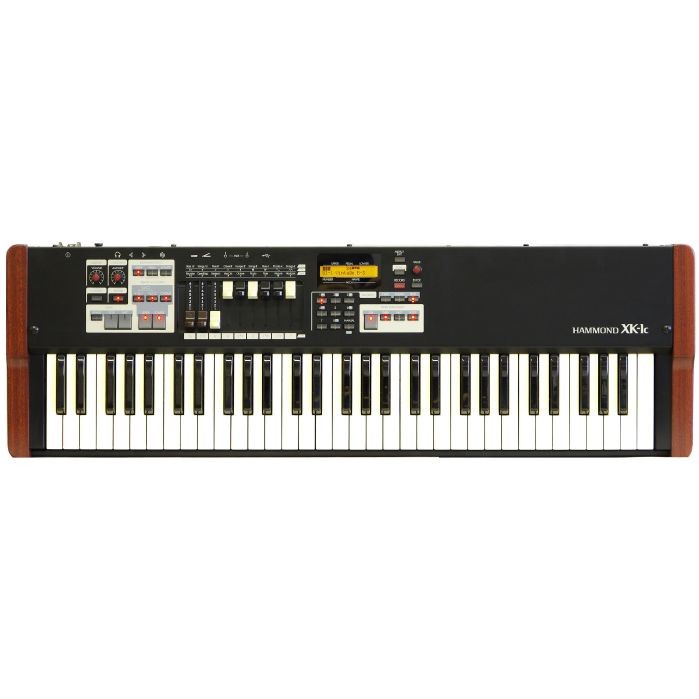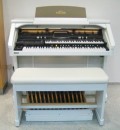Hammond XK-1c Portable Organ
- Product is : GERESERVEERD
- Levertijd : Niet meer leverbaar
- Leverings kosten : Dit product wordt gratis bezorgd
- Garantie termijn : 36 maanden
- Staat in de Showroom? : Ja
De Hammond XK-1c is de nieuwe sensatie van Hammond. Dit drawbar keyboard is klein, maar heeft nog steeds de sund van een Hammond in zich. Door de VASE III-engine is het geluid van de XK-1c fenomenabel. Deze wordt ook gebruikt bij de SK-serie van Hammond. Daarnaast is alles aanwezig en heeft het de volgende elementen in zich:
- pijporgelklanken;
- toonwielsimulatie;
- transistororgels;
- 9 drawbars;
- 5-octaafs waterfall klavier.
Normale prijs: € 1.758,00
Dera prijs : € 1.499,00
Introducing the smallest and lightest Genuine Hammond Organ… There was a time when the roaring sound of a genuine Hammond B3 Organ and Leslie Speaker required a moving van with burly movers, and room enough on stage to stand 4 regular musicians. Those days are truly now behind.
The Hammond XK-1c provides the full majesty and versatility of the industry standard B-3 in a compact package weighing just 7,5 Kg.
Following the lead of the wildly popular SK series of ultralight keyboards, the XK-1c uses the same Virtual Tonewheel “engine” as Hammond’s flagship B-3 mk2 Console Organ, with all the traditional elements, such as Hammond’s original Chorus/Vibrato and Touch-Response Percussion. The latest digital Leslie™ is also onboard, completing the classic setup, which is one of the most desired pieces of gear for any keyboard player in any genre of music.
The XK-1c features extensive customization capabilities, allowing the Organ to be tailored into replicating any Hammond/Leslie vintage, with all settings stored in each patch. Most common aftermarket “Hot Rod” modifications are possible within the editing facilities, as well. A wide variety of different Hammond tones are contained in the factory patch library. There are 64 Factory patches and 64 User-programmable patches available.
In addition to the Drawbar Profiles, the sounds of two of the most popular transistor combo organs are included, along with 28 equivalent ranks of Classical Pipe Organ sounds. The Combo Organ and Pipe Organ voices may be fully registered in traditional fashion via the Drawbar controls.
Hammond USA Director of Sales and Marketing Gregg Gronowski says: “The XK-1c’s diminuitive size is shocking when compared to its massive tone, but one touch of the traditional waterfall keyboard tells the truth that the XK-1c is the real deal, not a clone or imitation, but a genuine Hammond Organ, worthy of the name and the legacy of nearly 80 years.”
| Technische Informatie | GENUINE AND AUTHENTIC HAMMOND ORGAN Authentic Chorus-Vibrato/Touch Response Percussion/Overdrive 12 HAMMOND MACRO PROFILES with 17 TWEAKABLE PARAMETERS each USER-PROGRAMMABLE 3 BLANK USER-PROGRAMMABLE PROFILES 96 INDIVIDUALLY Adjustable, Voiceable Digital Tonewheels DIGITAL TONEWHEEL GENERATORLaurens Hammond’s original Organ (invented in 1935) had an intricate electro-mechanical mechanism that used 96 Quarter-sized wheels spinning on driveshafts powered by his patented synchronous motor. The wheels were notched according to pitch, and an electromagnetic pickup (much like that on an Eelectric Guitar) sensed those notches and rendered a musical note. The Drawbars combined those harmonic tones to produce the inimitable Hammond Organ sound. Hammond’s adherence to quality has allowed many vintage instruments to remain vital today, and they are among the most desired and imitated musical instruments ever, but at a high cost. The Electromechanical Hammonds require expensive maintenance, regular doses of oil, and were of great weight; not easy to move at all. The Modern Hammond Organ’sXk-1c’s VASE III “Engine” uses the exact model of Laurens Hammond’s design, executing it in the digital realm, with no moving parts, retaining all of the nuances, imperfections and idiosyncrasies of the original. The wheels are always “spinning”. When a note is played, the tones pass, just as water through a faucet. The random starts of each wave played allow for phase interaction, producing the rich tone so prized in the vintage Hammonds. The Digital realization of Laurens Hammond’s System allows sophisticated control of every facet. Each Digital Tonewheel can be voiced for Volume, Timbre, Motor Noise and Leakage; enabling the musician to tailor the Modern Hammond to match the characteristics of any Vintage Hammond, or to create their own vision. Twelve Macro Profiles allow the user to quickly select the most popular “kinds” of Hammond, from Showroom-New to Road-Worn Antique and all points between. CLASSIC HAMMOND COMPONENTSThe Tonewheel Generator wasn’t the only great invention of Laurens Hammond, and no Hammond Organ would be complete without the full spectrum of ingredients that comprised Mr. Hammond’s genius design. DRAWBARS: Mr. Hammond used the Pipe Organ Design concept of “Unification” in creating the iconic Drawbars of his Electronic Organ. This concept allowed one or more keyboards to control the pitches of many pipes within one set or “rank” of pipes. Adopting the harmonic standards and nomenclature of the Pipe Organ, Mr. Hammond’s design assured that any organist would be able to play his instrument without a steep learning curve. Unlike the Pipe Organ, Mr Hammond’s design allowed variable volumes of each Harmonic represented by each drawbar. This variation gave the musician millions of combinations of harmonics, and assured that every Hammond player would be able to summon a unique voice. An extra level to the expression a Hammond Organist had at their fingertips was added because the Drawbars could be manipulated in real time. The Xk-1c features real drawbars in the size, shape and configuration of Vintage Hammonds. The Drawbars also serve the Combo and Pipe Organ divisions, but with a slightly different function. VIBRATO/CHORUS: PIC OF VIB/CHORUS CONTROLSOne of the most distinctive parts of the Hammond sound is the shimmering “Chorus Vibrato”. It adds a silken quality to the sound by adding a second, slightly detuned pitch to the original in the Chorus Mode, and repeat-modulating the pitch slightly in Vibrato mode. Few musicians realize the Chorus effect pedal widely used for Guitars and Electric Pianos had its genesis as a component of the Hammond Organ. Mr. Hammond’s original design used an electromechanical apparatus that looked much like the distributors you would find in the automobiles of the day, and ran off the same synchronous motor that powered the Tonewheel Generator. The Xk-1c’s Chorus-Vibrato is executed in the Digital Realm, without moving parts, and works under the same model. The classic V1/V2/V3/C1/C2/C3 controls are familiar to anyone who has ever played a Hammond. As with the Tonewheel Generator, Digital control allows a wide range of adjustment that was simply not possible on the original. As the Antique organs aged, the components acquired their own unique qualities. Digital control allows the user to shape the Chorus/Vibrato’s various facets, with the added ability to “age” the effect-with the resulting treble emphasis and subtle distortion that marks the organs that develop this patina as “sweeter” than others. TOUCH-RESPONSE PERCUSSION™ PIC OF PERC CONTROLSThe chief feature of the Hammond B-3 upon its release in 1955 was the inclusion of Touch-Response Percussion™ (Perc). This effect added a high “attack” to the Organ tone at either the octave or the twelfth, with a fast note decay. This sound was reminiscent of an xylophone or clave, and became immensely popular, immediately. Perc gave the Organ a bright highlight, and every generation of music has embraced this sound. Controls for the Perc have the classic nomenclature, familiar to anyone who has ever played a Hammond. On the Xk-1c, Perc is executed in the Digital realm, allowing a wide range of controls the organists back in the day did not possess. The 1′ drawbar muting, characteristic of the Vintage Organs can be defeated, as can the drop in Drawbar volume level that accompanied the engaging of the Percussion voice. You can control the volumes and decay times as well. KEY CLICKIn order that every key (and pedal) of the Laurens Hammond’s Organ could access every Tonewheel as predicated by the Drawbar settings, an electro-mechanical apparatus lurked behind the keyboards, with 9 contacts corresponding to each drawbar for that keyboard and a series of contacts attached to each key. As a key was depressed, the contacts sequentially touched, and the circuits were completed to produce the Organ tone that was registered by the Drawbars. The very nature of Electric circuitry dictated a click could be heard at the top of each note played when the current-carrying key contacts touched. Laurens Hammond considered that click to be a nuisance, and worked to no avail in order to rid his organ of that imperfection. The jazz players who embraced the Hammond Organ, however, found the click to be a percussive highlight, and wanted nothing to do with its eradication. To make matters worse, as the Vintage Hammonds aged, the click became more pronounced, and by the Rock and Roll era, the Key Click assumed a role of importance that Laurens Hammond could never imagine. The Xk-1c allows you to adjust the intensity of the key ON click, and the key OFF click. The timbre of the click may also be adjusted. Mr. Hammond would have greatly approved of the Xk-1c, as you can turn the click all the way off if you desire, creating a Vintage Hammond Organ that could not exist in the physical world. THE “TONE” CONTROLThe inclusion of this obscure feature demonstrates the commitment to authenticity Hammond has brought to the Xk-1c Series. Inside the Vintage Hammond B-3, on one side of the tube preamp, there was a “Screwdriver Pot” with the engraved legend “Tone”. This control was adjusted by the Technician installing the organ in order to tame the treble response in the instance of the organ’s installation in a Church or Mortuary, where a more muted organ was desired. The control was a cocktail of upper Mid and High frequencies (the proportions of which were, until recently, held secret. The “Tone” control was basically a “hi cut” control and only went “down”. You could not direct the control to go “up” for “boost”. The TONE control is included in the Xk-1c’s menu with the added benefit of being able to BOOST the unique blend of frequencies, which adds a nice “edge” to the Xk-1c tone, if desired. |
|---|---|
| Instrument is: | GERESERVEERD |
| Bezorgkosten | Dit product wordt gratis bezorgd |
| Bezorgtijd | Niet meer leverbaar |
| Garantie | 36 maanden |
| Staat in showroom | Ja |
| Merk | Hammond |
| Maandaanbieding | Nee |
U kunt het onderstaande formulier gebruiken, om vragen te stellen over dit product.
U krijgt zo snel mogelijk bericht.





















